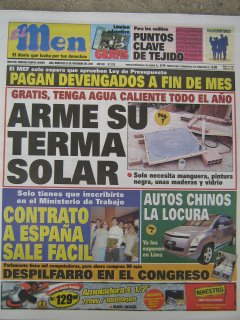
I´ve been taking photos and writing design documents in Spanish for all of the various devices that I´ve created (most of them adapted from other people´s inventions) so that anyone can build them. And after Sonia corrects my grammatical errors, I´m planning to publish them in a couple of places on the internet where ¨stove geeks¨ like me hang out.
Recently I noticed that one of the newspapers in Lima frequently publishes designs for wood-burning ovens and ideas for starting businesses or saving money. They even published a design for a biogas generator using guinea pig poop! So I emailed them the design for my solar water heater about a month ago. Since they never responded, I figured they weren´t interested. Then today my landlord showed me the front page of the newspaper, and there was my picture of the solar water heater on my roof! On page seven they published the steps for building it. The rest of the article (list of materials, principle of operation, suggestions for adapting the design) will be published tomorrow.


 se it. They´re now using it daily to cook about 40 pounds of rice. After bringing the rice to a boil for 5 minutes, they lift the pot into the RHC (luckily, it's a pot with four handles, because it takes more than two people to lift it!) They leave it for two hours, and the rice is done. At that time it´s still at 199 degrees F, so it stays nice and hot even if the rest of the meal isn´t ready for another hour or more. The women say that the rice is more evenly cooked than when they cook it over the gas stove. They proudly show off their new tool to all of the customers who come to buy their meals.
se it. They´re now using it daily to cook about 40 pounds of rice. After bringing the rice to a boil for 5 minutes, they lift the pot into the RHC (luckily, it's a pot with four handles, because it takes more than two people to lift it!) They leave it for two hours, and the rice is done. At that time it´s still at 199 degrees F, so it stays nice and hot even if the rest of the meal isn´t ready for another hour or more. The women say that the rice is more evenly cooked than when they cook it over the gas stove. They proudly show off their new tool to all of the customers who come to buy their meals.




